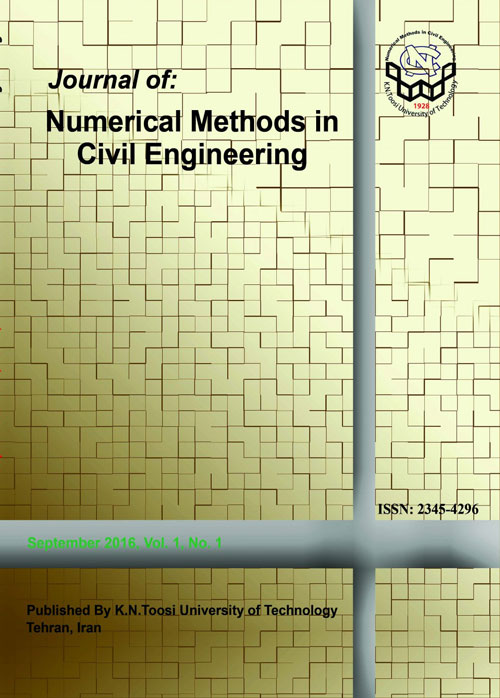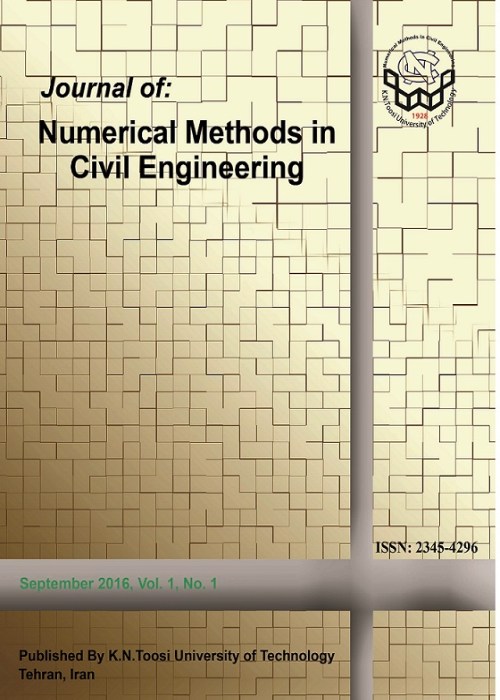فهرست مطالب

Journal of Numerical Methods in Civil Engineering
Volume:1 Issue: 2, Dec 2014
- تاریخ انتشار: 1395/10/15
- تعداد عناوین: 7
-
-
Pages 1-8Nowadays, Alkali Aggregate Reaction is considered as one of the most dangerous weak points of concrete and its occurrence has been widely reported in various structures. In the current study, a program is developed for predicting and examining the effects of mentioned reaction on the three-dimensional analysis of concrete structures such as arch dams. In this regard, a program provided for dam analysis is utilized applying necessary modifications on its flowchart to represent the reaction effects on the analysis procedure. The model utilized for simulating AAR is one of the comprehensive and newest models among the ones presented in various references. The deterioration of elasticity module due to the reaction is also included in the analyses, in addition to modeling concrete expansion with an excess load vector. The analyses conducted for considering the developed program capabilities indicates acceptable results so that its stability and accuracy are considered enough for long term prediction of performance of AAR-affected structures(especially concrete dams) during their service life.Keywords: Alkali Aggregate Reaction, Concrete arch dams, Elastic module deterioration, Finite Element Method
-
Pages 9-20The use of artificial neural networks has increased in many areas of engineering. In particular, this method has been applied to many geotechnical engineering problems and demonstrated some degree of success. A review of the literature reveals that it has been used successfully in modeling soil behavior, site characterization, earth retaining structures, settlement of structures, slope stability, design of tunnels and underground openings, liquefaction, soil permeability and hydraulic conductivity, soil compaction, soil swelling and classification of soils. The method of conjugate gradients provides a very effective way to optimize large, deterministic systems by gradient descent. In its standard form, however, it is not amenable to stochastic approximation of the gradient. Here we explore a number of ways to adopt ideas from conjugate gradient and Back Propagation in the stochastic setting, using fast Hessian-vector products to obtain curvature information effectively. In our benchmark experiments the resulting highly scalable algorithms converge about an order of magnitude faster than ordinary stochastic gradient descent. The objective of this paper is to provide a general view to describe this method in predicting mechanical behavior and constitutive modeling issues in geo-mechanical behavior of cohesive soil to be used in geo-mechanics. In this research the Batching Back Propagation method (BBP) has been employed and the characterized parameters are introduced as initial void ratio, liquid limit, plasticity index, natural density, moisture percent, solid density of grain, over consolidation ratio, and pre-consolidation pressure. The paper also intends to present how much the input memory may cover the accuracy of predicted behavior of standard triaxial drained and undrained tests. The paper also discusses the strengths and limitations of the proposed method compared to the other modeling approaches. Also, the sensitivity of intended parameters is investigated.Keywords: clay behavior, back propagation, conjugate gradient, artificial neural networks
-
Pages 21-30A finite element solution based on equevalent elements is proposed for the static and dynamic analysis of tallhigh tensioned cable antennas. To reduce high number of degrees of freedom in space frame body of a structure, a simple equivalent beam element is defined for each simulative substructure. This numerical procedure is applicable to analyze complex three dimensional assemblies of substructures of such similar complex structures. In this analysis wind pressure effects accompanied by change of postentioning loads in nonlinear cable elements, earthquake effects, and any other arbitrary loads on the substructures. Accordingly, the restriction of the loads on the cable elements to gravity and thermal loads can be applied. The algorithm is developed upon an efficient cable elements depending on the given position and curved geometry of the cable, its end forces, and its tangent stiffness matrix. The employed formulation scheme permits any magnitude of deformation for straight or curved elements. The postensioning stresses in cables were considered as initial stresses. To simulate the equevalent elements, both ends stiffness, damping and mass components are calibrated to present the same static and dynamic responses as the selected substructure. To simulate dynamic responses, the equevalent single mass matrix and its adjusted position are carried out to obtain the same frequencies in equevalent elements. The static solution of a complete structure compared well with the results presented by simulated model. This paper proposes an alternative structural analysis modeling strategy for guyed steel towers design, considering all the equivalent structural forces and moments, by using three-dimensional beam finite elements. Comparisons of the above mentioned design models with an alternative, that models the main structure and the bracing system with 3D beam finite elements, are made for existing guyed steel telecommunication towers (325m high). The comparisons are initially based on the towers static and dynamic structural behavior later to be followed by a linear buckling analysis to determine the influence of the various modeling strategies on the tower stability behaviour.Keywords: Non-linear cable, post-tensioned, equivalent element, natural frequency, stability analysis
-
Pages 31-40A two step method has been devised for the statistical inference of deformation changes. In the first step of this method and based on Procrustes analysis of deformation tensors, the significance of the change in a time or space series of deformation tensors is statistically analyzed. In the second step significant change(s) in deformations are localized. In other words, they are assigned to certain parameters of deformation. This is done using the Global Model Test. Because of the key role of Procrustes analysis in the proposed method for the inference of deformation changes, it has been given the name of Procrustean Statistical Inference of Deformations. The method has been implemented to synthetic and real deformations. The 3D-deformation tensors of a regional GPS network in the Kenai Peninsular, for analyzing the spatial variation of deformation tensors, and a local GPS network in Alps, for analyzing the temporal variation of deformation tensors have been used for illustrating the practical application of the proposed method.Keywords: Deformation Changes, Procrustes Analysis, Statistical Inference, Robust Estimation
-
Pages 41-47In this paper a constitutive model formulated in the framework of multi-laminate models is applied to analyze pipe-jacking processes. The multi-laminate -based models consider various integration planes to formulate the stress-strain relationship. This basic feature of the framework has the advantage that yield criteria, flow and hardening rules are formulated on planes rather than in three-dimensional stress space. In the proposed model, constitutive equations of the integration planes are derived based on the sub-loading surface plasticity framework. It is demonstrated that the development of large deformation and cracks formation which are the main difficulties in the simulation of pipe-jacking processes can be captured with this model. The ability of the model in the handling of these difficulties is verified with the simulation a laboratory pipe-jacking test. The simulation results show reasonable agreement with the test data.Keywords: multi-laminate framework, sub-loading surface model, pipe-jacking
-
Pages 48-56In this research, the variation of ultimate bearing capacity, failure mechanism and deformation pattern of soil beneath two closely square footings have been studied using numerical methods. It is assumed that the adjacent footings are constructed on the surface of sand. The presented numerical analyses are based on explicit-finite-difference code, FLAC3D. The elasto-plastic behavior of soil is modeled by using Mohr-Coulomb failure criteria along with associated flow rule for the soil. The reliability of constructed numerical simulation is investigated using available data on interfering footings. In addition, a large scale test is performed on two closely spaced square footings. Failure mechanism and deformation pattern are compared with the results obtained from numerical data. A pretty well agreement is observed between numerical and experimental results. The numerical analyses have shown a significant influence of interference on the failure mechanism and deformation pattern of the soil as well as the footing ultimate bearing capacity.Keywords: Footing interference, failure mechanism, deformation pattern, ultimate bearing capacity, square footing, finite difference method, FLAC 3D
-
Pages 57-66This paper presents a generalized numerical method to evaluate element stiffness matrices needed for the free vibration and stability analyses of non-prismatic columns resting on one- or two-parameter elastic foundations and subjected to variable axial load. For this purpose, power series approximation is used to solve the fourthorder differential equation of non-prismatic columns with variable geometric parameters. Then, the shape functions are obtained exactly by deriving the deformation shape of the column as power series form. Finally, the element stiffness matrices are determined by means of the principle of virtual work along the columns axis. In order to demonstrate the accuracy and the efficiency of presented method, several numerical examples including in the free-vibration and buckling analysis of non-prismatic columns, portal frame, and gable frame are presented and obtained results compared with the results of other available numerical and theoretical approaches. The method can be applied for the buckling load and natural frequencies computation of uniform members as well as non- prismatic members.Keywords: Stiffness matrix, Power series solution, Non, prismatic column, Buckling, vibration


